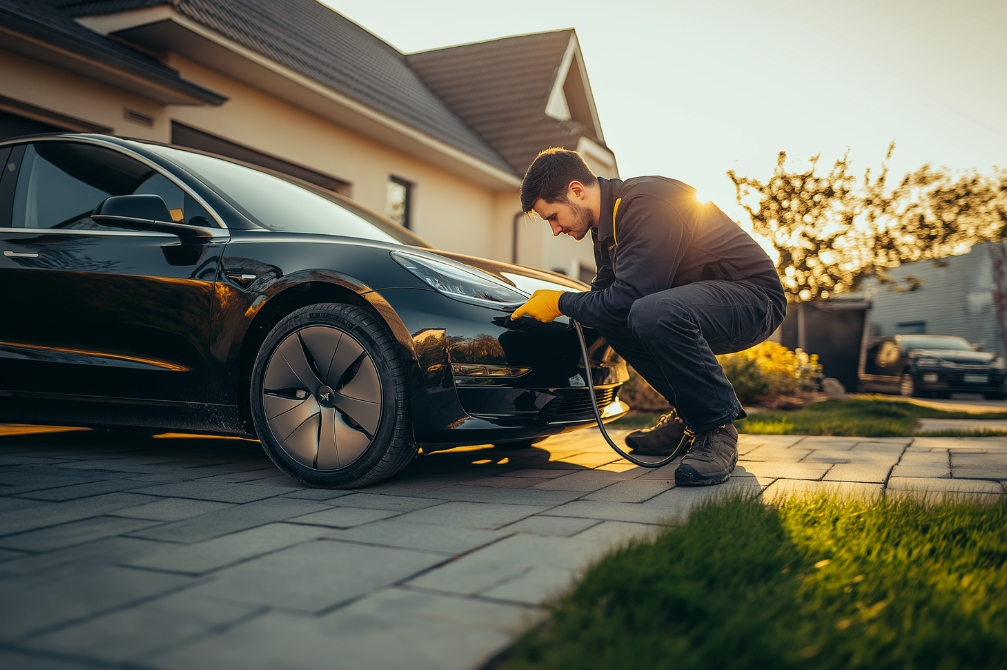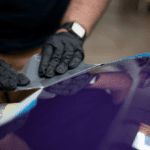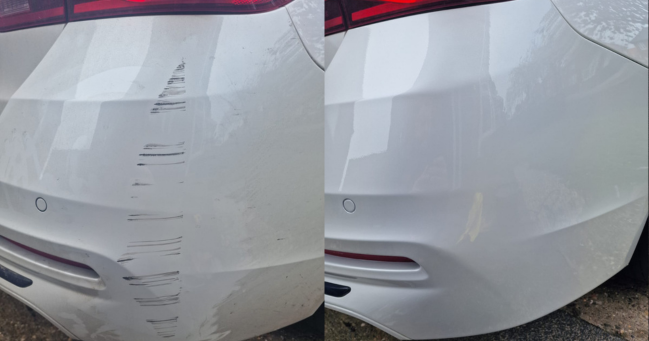
- February 20, 2025
A Comprehensive Guide to SMART Repairs
What is classed as a SMART repair?
SMART (Small to Medium Area Repair Technology) represents a specialised approach to vehicle bodywork repairs that focuses on efficiency and cost-effectiveness. Unlike traditional body shop methods that might involve complete panel replacements or extensive respraying, SMART repairs target specific damaged areas, preserving the original paintwork and structure wherever possible.
These innovative repair techniques have revolutionised the automotive cosmetic repair industry over the past decade, offering vehicle owners a practical alternative to conventional bodyshop visits. By focusing exclusively on the damaged area rather than entire panels, SMART repairs maintain the integrity of your vehicle’s original finish.
These repairs typically address:
- Paintwork scratches and scuffs – Treating minor surface damage without requiring full panel resprays. This includes light scratches from car parks, bushes, or everyday wear that hasn’t penetrated to the metal.
- Bumper repairs – Addressing dents, cracks, and scuffs on plastic bumpers. Modern bumpers, while designed to absorb impact, are particularly susceptible to parking damage and low-speed collisions.
- Alloy wheel refurbishments – Restoring wheels affected by kerb damage, scratches, or corrosion. Alloy wheels are particularly vulnerable to damage from potholes, kerbs, and road salt during winter months.
- Dents and dings – Utilising paintless dent removal (PDR) techniques to correct minor dents without disturbing the paint. This technique is particularly effective for hail damage, door dings, and minor impact dents.
The primary advantage of SMART repair lies in its ability to restore your vehicle’s appearance quickly and efficiently, eliminating the need for more expensive and time-intensive traditional repair methods. These techniques have been continuously refined to achieve results that often match or exceed conventional repair standards.
Are SMART repairs worthwhile?
Absolutely! SMART repair provides an excellent solution for minor cosmetic damage, offering several compelling benefits that make it increasingly popular among both private vehicle owners and fleet managers throughout the UK.
Cost-effective
By targeting only the damaged area rather than replacing entire panels or performing complete resprays, SMART repairs are considerably more affordable than conventional body shop work. This localised approach significantly reduces labour costs and materials usage, with savings typically ranging between 50-70% compared to traditional methods. For fleet managers, this cost efficiency translates to substantial savings across multiple vehicles.
Time-efficient
Most SMART repairs reach completion within just a few hours, making them ideal for busy vehicle owners who can’t be without their cars for extended periods. Traditional bodyshop repairs often require vehicle drop-offs lasting several days or even weeks for more complex work. The rapid turnaround of SMART repairs means minimal disruption to your daily routine—particularly valuable for those who rely on their vehicles for work or family commitments.
Preserves vehicle value
Promptly addressing minor damage helps maintain your vehicle’s resale value, as cosmetic imperfections can significantly impact market appeal. Professional evaluators and potential buyers alike scrutinise exterior condition during valuation. Well-executed SMART repairs are virtually undetectable, preserving your vehicle’s aesthetic integrity and protecting its market value. For lease vehicles approaching return dates, SMART repairs offer a cost-effective way to avoid excess wear-and-tear charges.
Eco-friendly
SMART repair techniques focus on localised treatments rather than extensive repainting, using fewer materials, generating less waste, and reducing environmental impact. The reduced use of paints, solvents, and other chemicals represents a significantly smaller carbon footprint compared to traditional repair methods. Many SMART repair specialists now use water-based paints and environmentally responsible products that further minimise environmental impact.
Convenience
Many providers, including The SMART Repair People, offer mobile services where technicians come to your location, eliminating the inconvenience of body shop visits. This door-to-door service means repairs can be completed while you’re at work, home, or even during shopping trips. Mobile units come fully equipped with specialised tools, paint-matching technology, and portable lighting to ensure professional-quality results regardless of location.
It’s worth noting that SMART repair works best for minor to moderate damage. Vehicles with substantial structural issues, deep scratches penetrating the base coat, or major panel deformations may require traditional body shop attention. A reputable SMART repair technician will always advise you honestly when damage exceeds the scope of SMART repair capabilities.
How much does SMART repair cost?
SMART repair pricing varies based on damage extent, repair type, service location, and vehicle make and model. However, these general guidelines can help set expectations for budgeting purposes:
- Scratch and scuff repairs – £80 to £250, depending on size and depth. Minor surface scratches typically fall at the lower end of this range, while deeper scratches requiring more extensive colour matching and blending will cost more. Premium or metallic paint finishes may incur additional charges due to the complexity of colour matching.
- Bumper repairs – £100 to £300, based on damage severity. Simple scuffs and minor cracks tend toward the lower end, while more extensive damage involving multiple repair techniques will approach the upper limit. Modern bumpers with parking sensors, cameras, or special finishes may require additional care and corresponding costs.
- Alloy wheel refurbishment – £50 to £120 per wheel. Factors affecting cost include wheel size, finish type (painted, diamond-cut, etc.), and extent of damage. Complete refurbishments, including straightening, crack repairs, and custom finishes, will command premium pricing. Many services offer discounted rates when refurbishing multiple wheels simultaneously.
- Dent removal (PDR) – £80 to £200 per panel, varying with size, location, and accessibility. Dents on flat, easily accessible surfaces cost less to repair than those on complex curves or double-skinned panels. Multiple dents on a single panel (such as hail damage) may qualify for package pricing.
- Interior repairs – £50 to £150, depending on material type and damage extent. Fabric tears are typically less expensive to repair than leather damage, while dashboard and trim repairs vary based on material composition and finish.
Compared to traditional body shop work, which can incur significantly higher costs due to labour and materials, SMART repairs offer a budget-conscious alternative without compromising quality. Many insurance policies now recognise SMART repairs as legitimate claim solutions, sometimes offering reduced excess payments for choosing this more economical option.
For accurate pricing specific to your vehicle damage, most reputable SMART repair companies offer free assessments and detailed quotes before commencing work. This transparency allows you to make informed decisions about repair options.
How long does SMART repair take?
One of SMART repair’s greatest advantages is its efficiency. Most repairs are completed within a few hours, perfect for busy vehicle owners. Here’s what to expect time-wise for various repair types:
- Scratch and scuff repairs – 1 to 3 hours. Simple touch-ups might require just 60-90 minutes, while more complex colour blending across panel sections could extend to 3 hours. The drying time for paint and lacquer represents a significant portion of this timeframe.
- Bumper repairs – 2 to 4 hours. Minor scuffs can be addressed in around 2 hours, while repairs involving structural plastic welding, reshaping, and refinishing may require the full 4 hours. Modern bumpers with textured finishes or special coatings may require additional time for proper matching.
- Alloy wheel refurbishment – 1 to 2 hours per wheel for mobile services, though full workshop refurbishments may take longer. The complexity increases with diamond-cut finishes or wheels requiring structural repair before cosmetic treatment. Most mobile services can complete a full set of wheels in a single day.
- Dent removal (PDR) – 30 minutes to 2 hours, depending on dent size, location, and panel accessibility. Simple door dings might take just 30 minutes, while more complex dents requiring careful manipulation may need the full 2 hours. Multiple dents can be addressed sequentially during a single appointment.
- Interior repairs – 1 to 3 hours. Fabric repairs tend to be quicker, while leather restoration involves multiple steps including cleaning, colour-matching, repair, and protective coating application. Dashboard and trim repairs vary significantly based on material and accessibility.
With many SMART repair companies operating mobile services, technicians can perform repairs at your home or workplace, minimising disruption to your daily routine. Some services now offer evening and weekend appointments specifically catering to commuters and busy professionals who cannot accommodate weekday repairs.
Most reputable SMART repair specialists provide booking systems allowing you to select specific time slots rather than vague “morning” or “afternoon” windows, further reducing inconvenience. Many also offer courtesy car services for more complex repairs requiring several hours of work.
What are the 3 examples of repair?
SMART repair addresses numerous damage types across various vehicle surfaces. Here are three common examples that demonstrate the versatility and effectiveness of these techniques:
1. Paintwork Scratch Repair
Car owners frequently encounter scratches and scuffs from parking incidents, road debris, or minor collisions. These blemishes not only detract from your vehicle’s appearance but can also lead to corrosion if left untreated, particularly in the UK’s damp climate.
SMART repair specialists employ a combination of careful sanding, precision colour-matching, and expert polishing to seamlessly integrate the repaired area with surrounding paintwork. The process typically involves:
- Careful cleaning and preparation of the damaged area
- Precise colour matching using computerised paint-mixing systems
- Graduated sanding to create a smooth transition zone
- Application of primer where necessary
- Layered application of base coat to match factory finish
- Clear coat application and careful blending
- Polishing to match the surrounding panel sheen
Modern SMART repair techniques can address scratches up to the size of an A4 paper sheet while maintaining factory-quality finishes. The level of craftsmanship is such that professional evaluators often cannot detect properly executed repairs.
2. Bumper Scuff Repair
Bumpers frequently suffer scrapes, cracks, or dents from low-speed impacts in car parks, during parallel parking attempts, or from minor collisions. As bumpers represent both aesthetic and safety components, proper repair is essential.
SMART techniques can effectively fill, reshape, and repaint bumper damage without necessitating complete replacement. The repair process typically includes:
- Structural assessment to confirm the bumper’s integrity
- Cleaning and preparation of the damaged area
- Plastic welding or filler application to restore shape
- Texturing to match factory finish where applicable
- Primer application to ensure proper paint adhesion
- Colour-matched paint application
- Clear coat application and blending
- Final detailing and protection
Modern bumpers often incorporate parking sensors, cameras, and other technology. SMART repair technicians receive specialised training to work around these components without compromising their functionality.
3. Paintless Dent Removal (PDR)
Small dents caused by hail, shopping trolleys, or minor impacts often respond well to PDR—perhaps the most remarkable SMART repair technique. This method preserves the original factory paint, avoiding potential colour-matching challenges.
PDR involves carefully manipulating the dent from behind the panel without affecting the paintwork, preserving the original factory finish. The technique requires:
- Careful assessment of dent location and panel access points
- Selection of appropriate specialised tools
- Strategic placement of lighting to highlight the contours
- Gentle, incremental pressure application from behind the panel
- Precise manipulation to restore original contours
- Final inspection under varied lighting conditions
PDR specialists undergo extensive training to develop the tactile sensitivity and spatial awareness needed for this remarkable technique. When successful, PDR leaves absolutely no evidence that damage ever occurred, as the original factory paint remains undisturbed.
Can a SMART repair be done in bad weather such as rain?
Since many SMART repair services operate on a mobile basis, weather conditions can indeed influence the repair process. Rain, strong winds, and cold temperatures may affect paint curing, potentially compromising finish quality. Humidity levels and temperature fluctuations can impact drying times and final results.
British weather presents particular challenges for mobile repair services. Winter temperatures can slow paint curing, while summer humidity might affect finish quality. Rain and wind can introduce contaminants that compromise adhesion and durability.
To address these challenges, professional SMART repair technicians typically utilise portable gazebos or work within sheltered areas like garages to protect the repair site from environmental elements. These portable workspaces often include:
- Industrial-grade weatherproof canopies
- Portable heating systems for temperature control
- Specialised lighting rigs that simulate daylight
- Dust extraction equipment to maintain air quality
- Moisture control systems for optimal humidity levels
During particularly adverse weather conditions, rescheduling may be necessary to ensure optimal results. Reputable SMART repair companies maintain flexible booking systems that account for weather forecasts, sometimes offering indoor workshop alternatives during prolonged periods of inclement weather.
Some premium services now operate custom-built mobile units with climate-controlled environments, allowing year-round repairs regardless of external conditions. These specialised vehicles represent the cutting edge of mobile repair technology, though they typically command higher service rates.
Can you SMART repair a car roof?
SMART repairs typically target lower vehicle sections where damage remains localised and easily accessible. Roof repairs present unique challenges because:
- The roof presents a large, exposed surface area, making colour blending more challenging due to lighting differences and visibility
- Extensive damage may necessitate a complete respray to maintain consistent finish quality
- Working at height adds complexity to the repair process and may require specialised equipment
- The horizontal orientation makes dust contamination more likely during the repair process
- Paint application on horizontal surfaces requires different techniques to prevent runs and sags
That said, minor scratches, small dents, or clear coat damage on a car roof may still respond well to SMART techniques. Modern SMART repair methods have evolved to address these challenges through:
- Specialised blending techniques for horizontal surfaces
- Mobile scaffolding systems for safe roof access
- Custom-designed dust extraction systems
- Accelerated curing methods suitable for larger areas
- Advanced polishing techniques specific to roof finishes
We recommend consulting a specialist to assess whether SMART repair suits your specific situation. A reputable technician will evaluate factors including damage extent, roof material (metal, glass, composite), and finish type before recommending the most appropriate repair approach.
For panoramic glass roofs or vehicles with special roof treatments (carbon fibre, wrapped, or matte finishes), additional considerations apply, and specialised expertise may be required.
Can you SMART repair a bonnet?
Like roofs, bonnets present challenges for SMART repairs due to their visibility and exposure. The bonnet represents one of your vehicle’s most prominent features, making flawless repair particularly important. Nevertheless, minor scratches, stone chips, and small dents often respond well to SMART techniques. More substantial or widespread damage may require traditional body shop attention.
For bonnet repairs, factors including damage size, paint colour matching requirements, and accessibility determine SMART repair viability. Significant damage may necessitate a full respray for optimal results.
Bonnets present unique considerations including:
- Heat exposure from the engine affecting paint curing
- Complex contours requiring skilled blending techniques
- High visibility demanding perfect colour matching
- Varied materials including aluminium, steel, and composites
- Special finishes including vents, scoops, and decorative elements
Modern SMART repair techniques for bonnets typically involve:
- Comprehensive cooling before repair commencement
- Specialised heat-monitoring during the process
- Advanced blending techniques for high-visibility areas
- Custom mixing of paints to account for bonnet-specific weathering
- Multiple-angle inspection processes to ensure perfect matching
For vehicles with performance bonnets featuring special materials or aerodynamic elements, consultation with marque specialists may be advisable before proceeding with SMART repairs.
Additional Considerations for SMART Repairs
Choosing a Qualified SMART Repair Specialist
Not all SMART repair providers deliver equal quality. When selecting a service, consider:
Technician qualifications – Look for IMI (Institute of the Motor Industry) accreditation or equivalent automotive refinishing qualifications. Properly trained technicians understand the chemistry and techniques necessary for durable repairs.
Insurance and guarantees – Reputable services offer workmanship guarantees (typically 1-3 years) and carry comprehensive insurance covering your vehicle while in their care.
Reviews and portfolio – Examine before-and-after examples of their work and check independent review platforms for customer experiences.
Equipment quality – Professional services invest in high-grade tools including spectrophotometers for colour matching, professional-grade spray equipment, and specialised lighting for inspection.
Preparing Your Vehicle for SMART Repair
To ensure optimal results, consider these preparation steps:
- Thoroughly wash the area surrounding the damage before your appointment
- Remove valuable personal items from the repair vicinity
- Provide access to electricity if the repair is being conducted at your home
- Clear sufficient space around the vehicle (approximately 2-3 metres)
- Have your vehicle’s paint code available if possible (found on the VIN plate)
SMART Repair Limitations
While remarkably versatile, SMART repair cannot address all automotive cosmetic issues. Limitations include:
- Structural damage affecting panel integrity
- Rust perforation requiring metal replacement
- Extensive damage covering more than approximately 30% of a panel
- Certain specialty finishes including some pearls and colour-shifting paints
- Heritage vehicles requiring historically accurate restoration techniques
Conclusion
SMART repairs offer a fast, affordable, and convenient solution for addressing minor cosmetic vehicle damage. They provide a cost-effective alternative to traditional body shop work while preserving your vehicle’s value and original finish.
The evolution of SMART repair techniques continues to expand their capabilities, with ongoing innovations in tools, materials, and methodologies. What began as a niche service has developed into a mainstream repair option recognised by manufacturers, insurers, and vehicle owners alike.
While SMART repairs excel at addressing scratches, dents, and bumper scuffs, they may not suit large-scale damage or highly visible areas like roofs and bonnets. When uncertain about SMART repair suitability for your vehicle, consulting a professional always represents the wisest course of action.
For reliable, high-quality SMART repairs, consider The SMART Repair People – a trusted mobile service bringing expert craftsmanship directly to your location. Their combination of technical expertise, premium materials, and customer-focused service ensures your vehicle receives the care it deserves.
By understanding the capabilities, limitations, and appropriate applications of SMART repair techniques, you can make informed decisions about maintaining your vehicle’s appearance, preserving its value, and extending its aesthetic lifespan.


